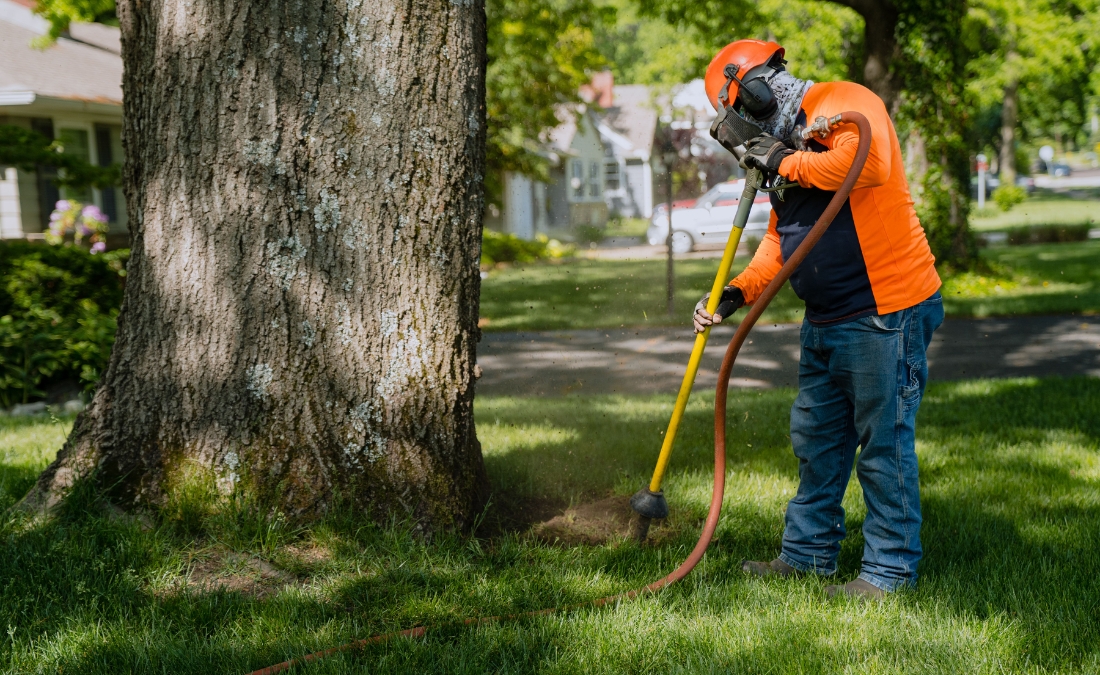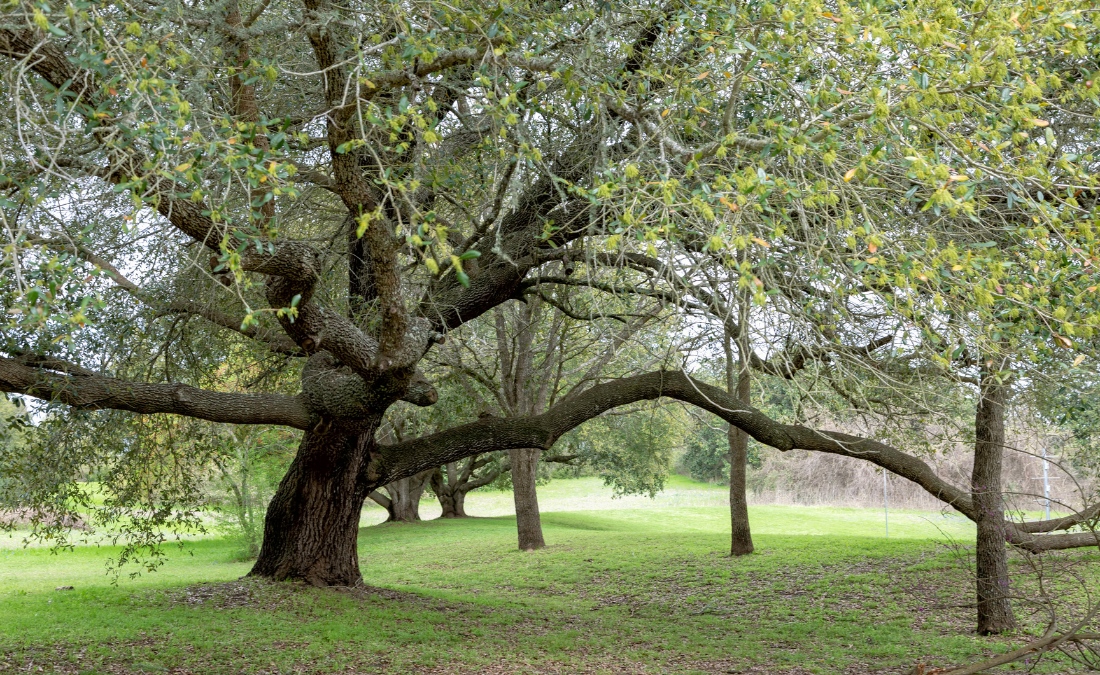Spotting the Signs of a Dangerous Tree: When to Call a Fort Worth Tree Removal Expert

Due to structural defects or external issues, trees can quickly become hazardous in Fort Worth. Arbor Masters explains the 6 signs of a dangerous tree.
Unhealthy and hazardous trees can quickly turn from a peaceful part of your yard to a serious danger to your home. Recognizing the warning signs of a potentially dangerous tree is important in preventing costly damage and ensuring the safety of your property. Here are the six most common indicators that your tree may be a safety hazard.
Key Takeaways
- Codominant stems (multiple trunks) can make trees more susceptible to splitting during storms, and cabling or removal may be necessary to reduce the risk.
- A leaning tree, especially one with more than a 10-degree tilt, poses a significant danger of uprooting in severe weather and may require removal.
- Shallow, exposed roots can destabilize a tree and increase the risk of it leaning or falling, as well as attract pests and diseases.
- Cracked or damaged bark can invite harmful insects and diseases, and deep cracks may require the attention of a Certified Arborist.
- Internal decay, often hidden within the tree, can weaken its structure, and a professional arborist can assess whether the tree is still safe or needs removal.
6 Signs Your Fort Worth Tree Is a Safety Hazard
Some signs of dangerous trees in Fort Worth are reasonably apparent to anyone, while others may require the expertise of an ISA Certified Arborist. Regardless, these are signs that your tree may be a risk to your family and property.
WARNING: Determining whether a tree is hazardous can be challenging for most homeowners. It’s best to have a professional arborist assess your tree and provide an accurate diagnosis before making any conclusions about its safety.

Trees with codominant stems are more prone to cracking from extreme weather. Photo courtesy of Joseph OBrien, USDA Forest Service, Bugwood.org.
1. Your Tree Has Multiple Trunks
A tree with codominant stems (multiple trunks) poses a major risk of breaking. Most trees have one central trunk because it is the strongest way to develop. Pruning young trees can prevent the development of multiple leaders, but once a tree matures with codominant stems, it can pose a significant risk to Fort Worth homeowners.
Trees with multiple trunks are more likely to split during storms, increasing the potential for damage. If you spot a tree with codominant stems, it’s important to consult an arborist. They may recommend cabling to stabilize the tree or, if the risk is too high, removal as the safest option.
2. Your Tree Has a Lean
Trees should come straight up from the ground, with a few degrees of natural lean. When a tree leans more than 10 degrees, however, it can become a significant risk to your property. That’s because a leaning tree is more likely to uproot during a storm. In most cases, the only thing to do with a leaning tree is remove it to prevent it from falling.
3. Your Tree Has Roots Above Ground
In Fort Worth, most trees develop deep roots to keep them stable and provide access to water and nutrients. For instance, oak tree roots can grow as deep as four feet underground. If you notice roots appearing near the surface, it could be a sign that your tree is in trouble.
Roots are essential for holding trees firmly in place, but shallow roots just can’t do the job as effectively. This can cause a tree to lean or even uproot during storms or severe weather, which can put your property and safety at risk.
Shallow roots are also more prone to damage from lawnmowers or other human activity. The damage acts as an open invitation for attacks from insects and diseases.
4. Your Tree Has Cracked Bark
In an ideal scenario, the bark of your tree should be free of damage and completely cover the tree like a suit of armor. Cracks in your bark act as an open invitation for insects and diseases to cause further harm to your trees.
Some trees naturally develop cracks in their bark, and superficial cracks are likely not a cause for concern. But if the crack is deeper and you can see split wood, it may be time to have an ISA Certified Arborist examine your tree and determine the best course of action.

A bur oak tree showing signs of internal decay. Photo courtesy of Joseph OBrien, USDA Forest Service, Bugwood.org.
5. Your Tree Has Signs of Decay
Internal decay is a problem that can create a dangerous tree. Decay typically happens from the inside out, so by the time you see it, your tree will already have soft, mushy wood throughout.
Internal decay is not always a death sentence or a sign your tree is at risk. If there is a large enough percentage of solid wood compared to decayed wood, the tree will remain structurally sound. Determining how much decay there is takes specialized training and knowledge, so leave the diagnosis to an ISA Certified Arborist.
6. Your Tree Has an Insect Infestation or Disease
Some disease problems can be minor for your trees, like anthracnose. Others can kill your trees and leave them as a danger to your property.
Here in Fort Worth, two of the most dangerous problems our trees face are emerald ash borer (EAB) and oak wilt. EAB has devastated the ash tree population in the Dallas-Fort Worth area, while oak wilt has killed more than one million trees throughout Central Texas.
If your tree looks generally unhealthy or you notice increased insect activity, it may be time to call a Certified Arborist and have them inspect your tree. They may suggest treatment options or removal if the tree is too far gone.
PRO TIP: Want to learn more about some of the problematic insects and diseases in the Fort Worth area? See our previous articles on some of the common problems in our area:
Frequently Asked Questions About Dangerous Trees
What should you do if you think you have a dangerous tree?
Call an ISA Certified Arborist if you have a tree with a dangerous lean or showing symptoms of attacks from insects or diseases. They can diagnose what is wrong with your tree, explain the risk to you, and provide objective advice on what’s best moving forward.
Are all dead trees hazardous?
Dead trees are only hazardous if they are in danger of hitting something and are structurally weak. In the industry, we have a saying, “No target, no hazard.” If you have a large yard, you may even keep a dead tree standing to allow birds and mammals to use it as a shelter.
Is tree removal the only thing I can do for my dangerous trees?
No, tree removal isn’t the only thing to do for a hazardous tree. An arborist may suggest cabling and bracing to support weak sections of a tree or treatment for insects and diseases. If the tree is too far gone, a Certified Arborist will likely suggest removing the tree to protect your home and family.

Arbor Masters is Ready to Help Remove Hazardous Trees
Trees are a boon to your property but also create added risk. When you have an unhealthy tree that is worrying you, it may be time to request the help of a professional Certified Arborist. They can diagnose the problems with your trees and help safely remove them if necessary.
We are ready to help you with any hazardous tree situations you may have. Our team includes ISA Certified Arborists who lend their expertise to every job we take on. Call us today at 469-586-5829 or request a quote online.

Get the latest local news, tree care tips, special offers, and company updates directly to your inbox! It's easy to subscribe and there's no spam - we promise.
"*" indicates required fields





